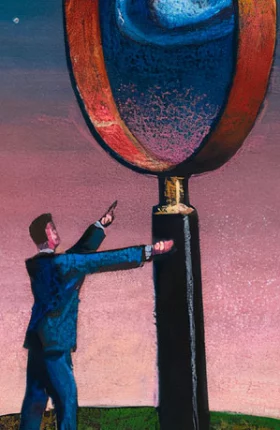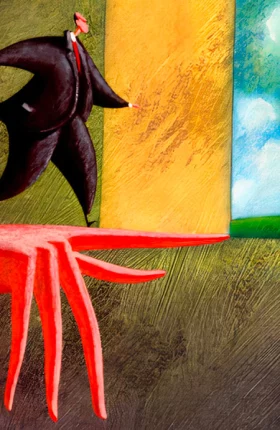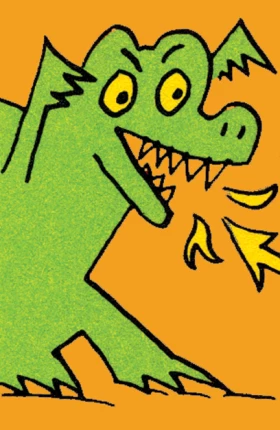“Change” describes the transition from same to different. Ancient Greek philosophers questioned whether there was such a thing as change. Today, by contrast, the concept of change is well established—in fact, people often grumble about the difficulty of keeping up with the pace of change in modern life.
Change can carry negative connotations. It can be easy to dwell on the unsettling aspects of disruption—all the commotion and uncertainty—and miss taking advantage of a fresh start. That’s why crisis management relies so much on shaping people’s perceptions. In times of crisis, a company has to summon the confidence to act and make decisions.
The story of Hansel and Gretel, taken from the fairy tale collection of the Brothers Grimm, can be read as a crisis of survival. With no help from their parents or friends, Hansel and Gretel must free themselves from slavery and ultimately defeat the evil witch. This fairy tale shows us the detours and successful strategies on the way to a final goal, be it eternal happiness or—in the case of a company—economic success. It also shows that the will to change and master a situation must come from oneself, not from others.
For the family of Hansel and Gretel, life itself was a crisis. They were preoccupied with pure survival, with having enough to eat. The stepmother proposes a solution that goes far beyond anything that might be deemed normal: she wants to abandon the children in the woods so there will be two fewer hungry mouths to feed. The father, distressed but too weak to fight back, acquiesces. The monstrous decision is made. The following day, the stepmother carefully and calmly carries out her plan.
Lesson 1: Old Tools Can’t Always Fix a New Kind of Crisis
The crisis did not come as a total surprise to Hansel and Gretel. In the same way that managers might observe dark clouds on the economic horizon, the two children had overheard their parents’ conversation and prepared themselves: Hansel collected shiny pebbles and, by dropping them along the path as the children were led deeper and deeper into the woods, managed to find the way home—much to their stepmother’s annoyance.
But a crisis is not a crisis if it does not quickly become even more serious. The stepmother tries again. This time, she locks the doors at night so the children cannot get out to collect any pebbles. The children respond by adopting the same strategy that worked once before, only with slightly different materials. They save the last bits of the bread they'd been given for breakfast and put them in their pockets. As they are taken ever deeper into the forest, they leave a trail, one crumb at a time, so they can find their way home again. But birds eat the crumbs, and the children realize that their previously successful strategy has failed them at a critical moment.
Crises have a way of invalidating strategies that have worked well in the past. Tools such as shareholder value, scorecards, and benchmarking can be very useful for steering a business in stable times. As long as everything works properly, there is no reason to object to a tool-based strategy. But such tools are generally not sufficient during periods of great uncertainty.
Lessons 2: Simple Solutions May Not Necessarily Be Helpful Solutions
In their increasing desperation, the children become aware of a beautiful, snow-white bird that leads them through the forest to a tempting yet mysterious gingerbread house. The house seems to be not only a refuge but also a solution to the nagging problem of hunger—after all, it is a house that can be eaten. The occupant of the house invites the children in with the usual temptations and promises. And so Hansel and Gretel are thrust into a “bewitching” situation—but one that quickly becomes perilous as the witch (as she predictably turns out to be) reveals her terrible plan to fatten and ultimately devour the children.
When business results are more red than black and when classic management levers no longer lead to a turnaround, the situation can seem as hopeless as it appeared to Hansel and Gretel in the gingerbread house. And bewitching solutions—like cutting costs, slashing R&D budgets, and the like—can be very attractive.
Lesson 3: Fight the Crisis by Leaving Your Comfort Zone
Hansel and Gretel go from the frying pan into the fire. They are welcomed by the witch, only to find themselves imprisoned, awaiting a grim fate. But at the very last moment, Hansel and Gretel grab the controls and become the masters of their fate. Gretel feigns ignorance and persuades the witch to show her how to climb into the oven. We know how it ends—with the wicked witch burning to death and the children reunited with their father.
Gretel’s solution was not analytical but fundamental. She regained her freedom through a heroic deed. It was a decisive moment, one in which the crisis became an opportunity for liberation. Obviously, the situation had to be very dire before the children could pluck up the courage they needed to liberate themselves.
Managers who find themselves in an extraordinary situation and want to break free from traditional constraints will only be able to do so if they reexamine their goals—and their strategies.
Wrap-Up: Sovereignty Can Help Solve a Crisis
Uncertainty is a fact of life, especially in business. And when uncertainty attacks with unmitigated force, we speak of a crisis. Although we all fear a crisis, it can serve an important function by forcing you onto a path you wouldn’t have dared walk before.
It can be an emboldening, even enlightening, experience. When you step outside your comfort zone, you have a chance to discover new and sometimes unexpected ways to push past uncertainty. The crisis, once a formidable roadblock, becomes an opportunity to embark on meaningful, positive change.
But for some people (and some companies), a crisis can be more disorienting than liberating. When that happens, it is not tools that help but the reassertion of sovereignty—with the decision maker acting freely and no longer at the mercy of events. Strategy demands free decisions, a real choice, the courage to follow the path chosen and to resist “bewitching” solutions. Once the spell is broken, many problems virtually solve themselves.
A sovereign company is strong enough to resist swimming with the current. In every downturn, there are companies that increase rather than reduce their advertising spending, that conduct more R&D rather than less, that enhance their resources relative to their competitors. Value can be increased by anticyclical behavior. There are companies that do not fall victim to the siren song of the capital market by trying to please the analysts with steadily rising earnings every quarter, but instead do what is right in the long term—even though they are subject to the criticism of the self-appointed market observers along the way.
A strong independent streak won’t make a company immune to crises, but it will serve it well when the time comes to deal with difficult, unforeseen events.




